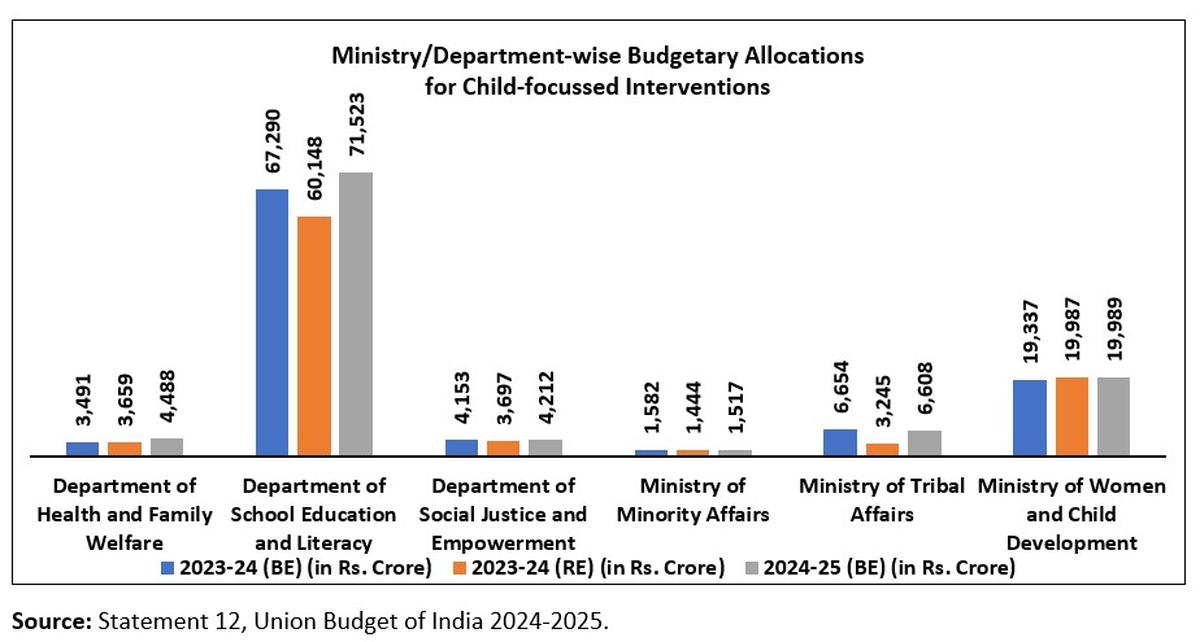Let us look at the overall picture in the Union Budget 2024-25 as far as children are concerned. The overall allocation for children is ₹1,09,921 crore, which marks a 5.5% increase from the previous year; 77.3% of the child Budget is allocated to education.
Union Finance Minister Nirmala Sitharaman’s full Union Budget speech outlined India’s plan to become an economic powerhouse or the vision of a Viksit Bharat by 2047, with a continued focus on the four major categories of the population, i.e., the poor, women, youth, and farmers. There is an emphasis on addressing immediate needs such as employment, skilling, and a focus on micro, small and medium enterprises and the middle class, with a specific focus on thematic domains that include agriculture, urban development and energy security. The overall fiscal outlay in the Union Budget 2024-25 (Budget Estimate – BE) stands at ₹4,820,512 crore, an increase of 7% over the 2023-24 (BE) and 7.3% over 2023-24 (Revised Estimate – RE).
This year, the Child Budget has seen a 5.5% increase when compared to the previous fiscal year, and a 17.4% rise over the RE for 2023-24. In absolute numbers, the total Child Budget (in the Union Budget) stands at ₹1,09,921 crore for 2024-25 (BE), while it was ₹1,04,180 crore for 2023-24 (BE). This year, the allocation for the Child Budget is 2.28% of the overall Union Budget (BE), as compared to 2.31% in 2023-24 (BE).

Budgetary allocations by Ministries
Breaking down the allocations for child-focused interventions by Ministries, the share of the Department of School Education and Literacy stands at 65.1%, marking a 6.3% increase compared to the previous year. The share of the Ministry of Women and Child Development stands at 18.2%, followed by the Ministry of Tribal Affairs at 6% and the Department of Health and Family Welfare at 4.1% of the total child Budget.

From a sectoral lens of the four major verticals, i.e., child education, development (including nutrition), health and protection, child education accounts for 77.3% of the allocations for child-focused interventions followed by child development at 16.7%, and child, and child health at 4.1%, marking a notable increase of 28.9% from the previous year. Child protection accounts for 1.8% of the Child Budget allocations, marking a 4.6% increase from the previous year.
Allocations across child-related schemes
The Budget for children demonstrates a substantial increase in allocations for education schemes. Pradhan Mantri Schools for Rising India (PM SHRI), an over-arching government programme for the school education sector from the pre-school level to Standard 12, which is to be implemented at the State/Union Territory levels through the existing structure available for Samagra Shiksha Abhiyan) has received a substantial 51.3% increase in allocation, while Pradhan Mantri Poshan Shakti Nirman, or PM POSHAN — a centrally sponsored scheme by the Department of School Education and Literacy — has received a 7.5% increase. Samagra Shiksha Abhiyan, a centrally sponsored scheme aiming to provide inclusive and equitable quality education to all levels of school education in India) has witnessed an increase of 0.1% in allocation.
For social justice and empowerment, there has been a 27.2% increase in allocation for SRESHTA, or the Scheme for Residential Education for Students in High Schools in Targeted Areas, which is a centrally sponsored programme that aims to improve the educational and socio-economic conditions of Scheduled Caste students. The allocation for Boys and Girls Hostel for Other Backward Classes has seen an increase of 33.3%.
In tribal affairs, there have been increases in allocations for Pre- and Post-Matric Scholarships for Scheduled Tribes (STs) by 7% and 20.5%, respectively. The Eklavya Model Residential Schools (EMRS) has seen an increase of 134.8% in the current year’s allocation over the previous year’s revised estimate.
Alignment with global commitments
As a signatory of the United Nations Convention on the Rights of the Child (UNCRC), India is mandated to ensure that its children are provided with a conducive environment to learn and develop as individuals who are protected against hazards, trauma, harassment, and other forms of violence and disasters.
In keeping with the commitment, National Pension System (NPS)-Vatsalya, as mentioned in the Budget proposal, is a significant step. This is a plan for contribution by parents and guardians for minors, which can be converted into a normal NPS account when the beneficiary child attains the age of 18 years.
On the whole, several child-related schemes have seen significant increases in budgetary allocation, which is a crucial step towards enhancing the welfare of children. However, there are some significant schemes, especially those related to nutrition, education (particularly scholarships), and protection, which would have required more attention and allocation to ensure that every dimension required for the growth and development of children is taken care of.
Children should remain a focal point in India’s development agenda. A significant step towards this is the Budget Circular of the Ministry of Finance, which directs all Ministries/Departments to form a ‘Gender and Child Budget Cell’ and appoint a nodal officer for this purpose. By placing children at the centre of the development discourse, a more inclusive and equitable future can be created, thereby ensuring that every child’s potential is realised.
Puja Marwaha is the CEO of Child Rights and You (CRY)
Published – October 04, 2024 12:12 am IST
